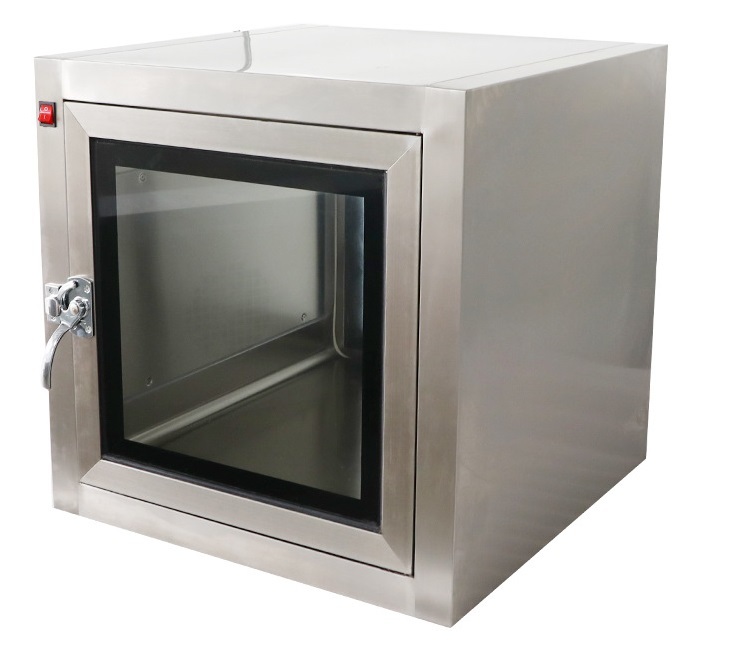Table of Contents
In the world of cleanroom environments, maintaining the integrity of contamination control is critical. A key component that helps maintain cleanliness is the cleanroom pass box. These boxes facilitate the transfer of materials between clean and non-clean areas while minimizing contamination. If you’re planning to purchase a pass box for your cleanroom, it’s important to understand the difference between static pass boxes and dynamic pass boxes to ensure you make the best choice for your operations.
Definition
Static Pass Box
A static pass box is a device used to transfer materials between two different areas, usually with varying cleanliness levels, without involving airflow. The primary function of a static pass box is to act as a sealed transition space where materials can be passed without jeopardizing the cleanroom’s controlled environment. Static pass boxes are ideal for environments where materials being transferred do not require air filtration.
Dynamic Pass Box
On the other hand, a dynamic pass box is equipped with HEPA (High-Efficiency Particulate Air) filters and has an internal airflow system that creates positive pressure to ensure the air inside the box remains clean. Dynamic pass boxes are more suitable for transferring materials that need extra protection against contamination, especially when moving between higher-level cleanrooms and lower-level areas.
Structure
Static Pass Box Structure
The structure of a static pass box is relatively simple. It consists of two doors on either side, with an interlocking system that prevents both doors from being open simultaneously. This prevents cross-contamination. Some static pass boxes may include UV sterilization lamps to disinfect materials.
Dynamic Pass Box Structure
A dynamic pass box features a more complex design. In addition to the interlocking doors, it includes HEPA filters and an air circulation system that ensures continuous airflow. This ensures a higher level of cleanliness for sensitive materials. Some models also come with pressure gauges, making it easier to monitor internal conditions.
Function
Static Pass Box Function
The primary function of a static pass box is to allow materials to pass from one room to another without airflow interference. They are best for transferring non-critical items that do not require continuous air filtering, such as documents or tools.
Dynamic Pass Box Function
The dynamic pass box is designed for more stringent environments where air cleanliness must be maintained. The internal air circulation system, combined with HEPA filtration, helps remove any particles that may be on the materials being transferred. This function is crucial in maintaining cleanroom standards, particularly when handling critical components in sectors like pharmaceuticals or biotechnology.
Application
Static Pass Box Applications
Static pass boxes are commonly used in lower-level cleanrooms or less critical environments where air filtration is not essential. These boxes are ideal for industries such as food processing, manufacturing, and electronics, where contamination control is important but does not require the stringent air quality measures of high-level cleanrooms.
Dynamic Pass Box Applications
Dynamic pass boxes are designed for use in higher-level cleanrooms or more controlled environments where any airborne contamination can be catastrophic. Industries like pharmaceuticals, biotechnology, and hospitals rely on dynamic pass boxes for safe material transfer while maintaining the required cleanliness levels.
How To Use
Using a Static Pass Box
- Ensure the material is ready for transfer.
- Open one side of the pass box door and place the material inside.
- Close the door and ensure it is securely locked.
- The receiving party can open the other door and retrieve the material.
Using a Dynamic Pass Box
- Place the material inside the box and close the door.
- Allow the airflow system to operate and ensure the environment inside the box is clean.
- After the internal pressure and air filtration have stabilized, open the other door to retrieve the material. Some dynamic pass boxes include timers or alarms that signal when it’s safe to open the second door.
Cost
Cost of Static Pass Box
Static pass boxes are generally more affordable than dynamic pass boxes because they have fewer components and simpler functionality. The price can vary depending on the size, materials, and additional features such as UV lights or interlocking systems, but they are generally cost-effective for lower-risk environments.
Cost of Dynamic Pass Box
Dynamic pass boxes tend to be more expensive due to their advanced filtration systems and internal airflow mechanisms. HEPA filters, pressure gauges, and continuous airflow monitoring systems add to the cost. However, for high-level cleanrooms that require stringent contamination control, this investment is often necessary to maintain industry standards.
Conclusion
Choosing between a static pass box and a dynamic pass box depends on your specific cleanroom needs. Static pass boxes are cost-effective and sufficient for non-critical environments, while dynamic pass boxes offer higher levels of contamination control essential for high-level cleanroom operations. Understanding the structure, function, and application of each type will help you make an informed decision, ensuring your cleanroom maintains the highest standards of cleanliness and efficiency.
If you are in the market for a cleanroom pass box, consider your cleanroom classification and the level of protection required for the materials being transferred. Investing in the right pass box will save you time, effort, and potential risks in the long run.
If you are looking for a professional pass box manufacturer, welcome to contact us!




